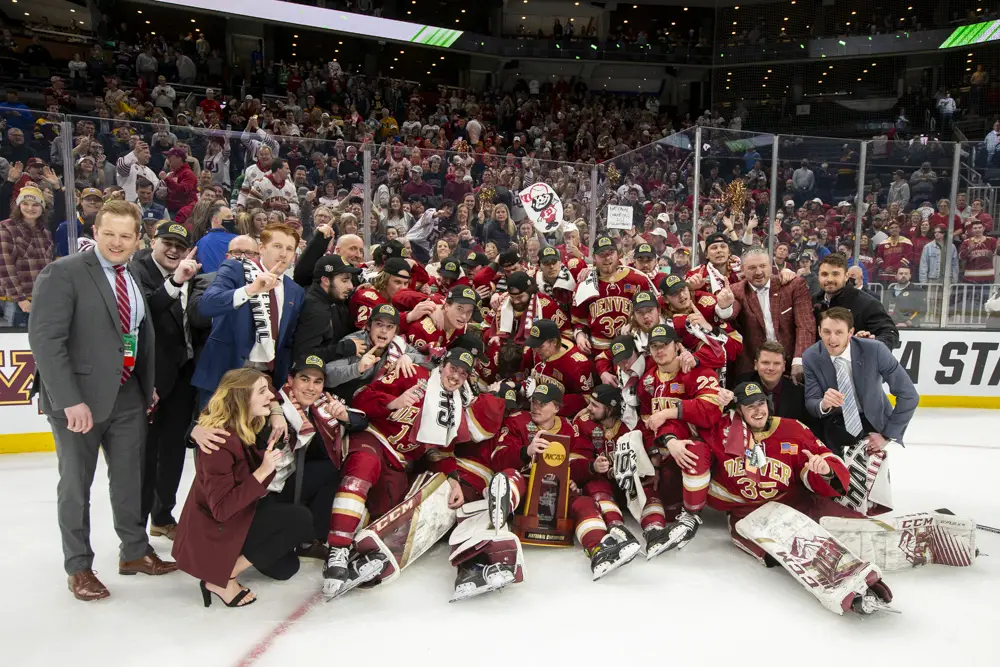
Welcome back to Bracketology, where we try to simulate the process that the NCAA Men’s Division I Hockey Championship committee will go through on Sunday, March 19.
We’ve discussed the selection criteria enough in the past, so if you need a refresher on what the PairWise Rankings are, head to this link.
All that said, the PairWise creates the field (minus the six conference champions). Thus, for purposes of this exercise, we will use the top 16 teams in the PairWise and, when necessary, insert each conference’s top teams to occupy that spot. Thus, we get a top 16 of:
- Minnesota*
- Quinnipiac*
- Michigan
- Denver*
- St. Cloud State
- Western Michigan
- Penn State
- Ohio State
- Boston University*
- Harvard
- Michigan Tech
- Minnesota State*
- Omaha
- Northeastern
- Cornell
- RIT*
* Indicates conference champion
What is required of the committee is to seed the brackets with the natural selection process – 1 should play 16, 2 should play 15, etc.
That said, there are exceptions that need to be made. The highest seeds should stay as close to home as possible. Also, teams within their bands (1-4, 5-8, 9-12 and 13-16) need to say within their bands.
Host teams must stay at home, which is an issue with just one team currently, Penn State, which is hosting the Allentown, Penn., regional. Otherwise, teams can travel without much restriction.
So here it the bracket, without regional assignments, that would be created based on the seedings alone:
- Minnesota
- Ohio State
- Boston University
- RIT
1. Quinnipiac
2. Penn State
3. Harvard
4. Cornell
- Michigan
- Western Michigan
- Michigan Tech
- Northeastern
1. Denver
2. St. Cloud State
3. Minnesota State
4. Omaha
When you look at these brackets, we have problems. The first is the first-round matchup between Cornell and Quinnipiac. It may seem wrong, but the easiest swap would be the take RIT away from #1 Minnesota and swap them with Cornell.
But the reality is the top seed earns the opportunity to play the lowest seed. So let’s think about seeding the top seeds into regions.
Let’s place the four regions: Minnesota makes sense in Fargo. Someone has to go to Manchester, which makes sense for the lowest top seed, Denver.
But what about Quinnipiac. They would make sense in Bridgeport, but Yale and Sacred Heart are the hosts. Thus, you technically can move Quinnipiac to Allentown, which when you consider attendance might make more sense. We’ll get back to that. If you do send Quinnipiac to Allentown, you can place Michigan in Bridgeport.
Then we can make some sensible swaps. The third seed makes the most sense. Boston University could move from Fargo to Bridgeport, much closer to help attendance. Harvard could move from Allentown to Manchester (and for all that, you could have BU in Manchester and Harvard in Bridgeport).
Once you do that, there are a lot of options to handle the lowest seeds.
RIT needs to stay in Fargo to maintain the 1 vs. 16 matchup. Omaha could move from Manchester to Allentown, a tiny bit closer to their campus, though not something that moves tickets (that said, Penn State sells out this region).
Cornell heads to Bridgeport with Boston University to give that region some shot at a decent attendance. And Northeastern makes sense in Manchester.
But I’m still left with the mental controversy of putting Quinnipiac in Allentown. When I think about it, even thought it maintains second-round bracket integrity, I can’t do it.
Thus, you have to flip Michigan (No. 3 overall) with Quinnipiac (No. 2 overall). Get a big attendance in Bridgeport and place Michigan in Allentown.
So the final brackets are:
Fargo
- Minnesota
- Ohio State
- Michigan Tech
- RIT
Allentown
- Michigan
- Penn State
- Minnesota State
- Omaha
Bridgeport
- Quinnipiac
- Western Michigan
- Boston University
- Cornell
Manchester
- Denver
- St. Cloud State
- Harvard
- Northeastern
That’s what we have for this week. Plenty of time for these regions to shift, not to mention the teams inside the bubble.
Last four in: Omaha, Northeastern, Cornell and Atlantic Hockey champion (RIT)
Last four out: Notre Dame, Alaska, Michigan State, Merrimack


